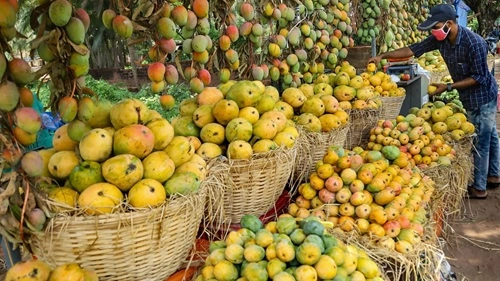See, when it comes to mangos, India quite literally is the biggest ever producer of this fruit in the entire world. Like, we produce as much as 25 million metric tonnes of mangos every single year, and no other country even comes close to this fiscal production. And it is not like there are some specific states only where mangos are grown in India, nah, there are many varieties of mangos that are grown in different parts of the country. So on that note, let’s talk about this list of the Top 5 Highest Mango Producing States In India 2025, shall we?

1. Uttar Pradesh
See, when it comes to Uttar Pradesh’s mango production, well, not even a comparison can be made. Just to take a look, Uttar Pradesh produced more than 2.5 million metric tons of mangoes in the year 2025, which is equivalent to nearly a quarter of the country’s total production.
UP’s supremacy is influenced by what factors? Volumes alone do not determine the outcome; however, the heritage is also essential. These areas have been producing these famous types of mangoes for many years, and they have become the typical types of the regions. Over time, these places have been producing impactful mango varieties such as Dasheri, Langra, and Chausa. Farming of mango is not only an additional source of income for the people of these areas, but it is also their agricultural culture.
2. Andhra Pradesh
In the second spot, and still very much holding its own, is Andhra Pradesh. The state is the annual producer of roughly 1.2 million metric tons of mangoes, which is about 22% of the total mango production in India. However, there is an interesting aspect, see, Andhra is not only a state that produces mangoes in large quantities, it is a giant in mango processing as well. The state has practically taken the whole supply chain from pulp to pickles to juices that are suitable for export. Mangoes like Banganapalli, Totapuri, and Neelam thrive in the perfect coastal belts.
3. Karnataka
Karnataka is ranked third with an annual production of around 1 million metric tons of mangoes. The thing that makes Karnataka different from other states is not only the quantity but also the high-quality varieties that it provides. Alphonso mangoes with rich fragrance and shining bright yellow color are the proud product of this state. Although Alphonso is primarily associated with Maharashtra, the production of Karnataka is gradually getting noticed, not only in the local market but also in the global market. Karnataka’s favorable climate for high sugar-content fruits and efficient export logistics has allowed it to become one of the most dependable suppliers of mangoes both in the local and international markets.
4. Bihar
Here is a state that is frequently disregarded yet manages to be ranked fourth on this list with a production of almost 800,000 metric tons of mangoes annually. Bihar takes a lot of advantage from the very fertile area of the Ganges plains, where the traditional types like Langra, Mallika, and Deshi mangoes have grown very well. The figures may be lower than the three leading states, but the continuous and robust production of Bihar is worth clapping.
5. Gujarat
Gujarat is in the fifth place with an annual production of 750,000 to 1 million metric tons, approximately. However, one variety specifically is the main reason why Gujarat is so well known, Kesar, which is commonly named the “Queen of Mangoes”. Kesar is a major export product that has a nice and sweet flavor, and its districts like Junagadh and Bhavnagar produce it in great quantities to satisfy the demand from foreign countries. The dry and warm weather of Gujarat might look harsh on its crops, but it is just perfect for Kesar mangoes.
Conclusion
There you have it, when it comes to mangos, these had to be the largest and highest mango-producing states in India as of 2025. And sure enough, mangos are super affordable in India because we produce tons and tons of these every single year, and sure enough, whenever the production goes somewhat wrong in any of these states, the effects of that can be seen on the overall supply of these fruits in the country and on the price as well.